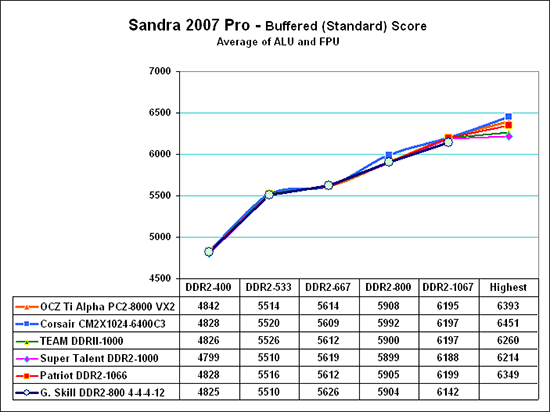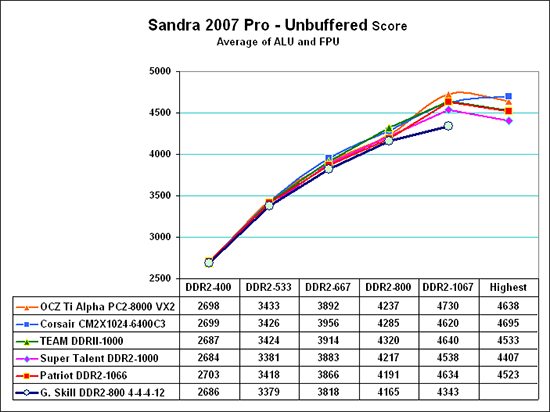Memory Bandwidth Scaling
Memory bandwidth normally improves with increases in memory speed and reductions in memory timings. This is best illustrated using Performance Scaling charts instead of the bar charts for individual speeds that were used in past memory reviews.
Since the results for high-end memory were so close at all tested speeds, the scale range was reduced to better show the small differences in these memory benchmark results. Please keep this in mind when viewing the charts, since a normal zero scale would make performance differences appear much smaller than these expanded scale charts. Maximum values for other memories at each speed are included in each chart for reference.
To evaluate memory bandwidth SiSoft Sandra 2007 Professional was used to provide a closer look at scaling for fast DDR2 memory.

The most widely reported Sandra score is the Standard or Buffered memory score. This benchmark takes into account the buffering schemes like MMX, SSE, SSE2, SSE3, and other buffering tools that are used to improve memory performance. Buffered bandwidth performance of the G.Skill memory was virtually the same as the previously tested high-end DDR2 memory to DDR2-800. Performance does drop a bit at DDR2-1066 due to the slower timings required of the mid-range G.Skill memory.
The Buffered benchmark does not correlate well with real performance differences in games, so our memory bandwidth tests have always included an Unbuffered Sandra memory score. The Unbuffered result turns off the buffering schemes, and we have found the difference in Unbuffered results correlate well with real-world performance differences.

In Unbuffered tests we see the G.Skill mirrors the best memory tested to DDR2-800. Performance does drop a bit if you run at slower timings and reduced voltage at DDR2-800. Again, at DDR2-1067, the penalty of 5-5-5 timings compared to 4-3-4 causes slightly lower results with the G.Skill. It is worth pointing out, however, that memory bandwidth, both buffered and Unbuffered, continues to increase with memory speed even though memory timings are a great deal slower at DDR2-1067.
We also compared results with Version 1.5 of Super Pi - comparing the time to calculate 2 million places of Pi at the different memory speeds. This benchmark measures pure number crunching.

Super Pi results continue to improve all the way to the highest speed that could be reached with stability with each memory. The second item that stands out is how very close the results with all the memories really are.. All 6 memories perform very similarly with just two exceptions. The G.Skill performs similarly until DDR2-1067 where slower timings finally provide a penalty. The Super Talent drops off a bit at the top and bottom due to slightly slower timings in those ranges. While performance is very close, Super Pi scaling charts continue to show the useful sensitivity of Super Pi as a measurement of memory performance
Memory bandwidth normally improves with increases in memory speed and reductions in memory timings. This is best illustrated using Performance Scaling charts instead of the bar charts for individual speeds that were used in past memory reviews.
Since the results for high-end memory were so close at all tested speeds, the scale range was reduced to better show the small differences in these memory benchmark results. Please keep this in mind when viewing the charts, since a normal zero scale would make performance differences appear much smaller than these expanded scale charts. Maximum values for other memories at each speed are included in each chart for reference.
To evaluate memory bandwidth SiSoft Sandra 2007 Professional was used to provide a closer look at scaling for fast DDR2 memory.

The most widely reported Sandra score is the Standard or Buffered memory score. This benchmark takes into account the buffering schemes like MMX, SSE, SSE2, SSE3, and other buffering tools that are used to improve memory performance. Buffered bandwidth performance of the G.Skill memory was virtually the same as the previously tested high-end DDR2 memory to DDR2-800. Performance does drop a bit at DDR2-1066 due to the slower timings required of the mid-range G.Skill memory.
The Buffered benchmark does not correlate well with real performance differences in games, so our memory bandwidth tests have always included an Unbuffered Sandra memory score. The Unbuffered result turns off the buffering schemes, and we have found the difference in Unbuffered results correlate well with real-world performance differences.

In Unbuffered tests we see the G.Skill mirrors the best memory tested to DDR2-800. Performance does drop a bit if you run at slower timings and reduced voltage at DDR2-800. Again, at DDR2-1067, the penalty of 5-5-5 timings compared to 4-3-4 causes slightly lower results with the G.Skill. It is worth pointing out, however, that memory bandwidth, both buffered and Unbuffered, continues to increase with memory speed even though memory timings are a great deal slower at DDR2-1067.
We also compared results with Version 1.5 of Super Pi - comparing the time to calculate 2 million places of Pi at the different memory speeds. This benchmark measures pure number crunching.

Super Pi results continue to improve all the way to the highest speed that could be reached with stability with each memory. The second item that stands out is how very close the results with all the memories really are.. All 6 memories perform very similarly with just two exceptions. The G.Skill performs similarly until DDR2-1067 where slower timings finally provide a penalty. The Super Talent drops off a bit at the top and bottom due to slightly slower timings in those ranges. While performance is very close, Super Pi scaling charts continue to show the useful sensitivity of Super Pi as a measurement of memory performance










30 Comments
View All Comments
MxChris - Sunday, November 5, 2006 - link
Thanks for the reply I'll try to get ahold of a G Skill rep and find out.Icepick - Friday, November 3, 2006 - link
I'd like to know this too. I purchased from the same product line only my memory is rated at 5-5-5-15 -> F2-6400CL5D-2GBNQ. I haven't been able to build my PC yet so I couldn't test them out. Are these micron chips too?Wesley Fink - Friday, November 3, 2006 - link
The 5-5-5 is the low-end G. Skill DDR2-800, selling for around $200 now, and most likely does not use Micron chips. There is also a higher-end DDR2-800 than we tested in this review rated at 3-4-3-8 timings. The highest rated dimms are likely the Micron D9GKX chips, but since we haven't tested that particular memory we cannot say that with authority.Doormat - Friday, November 3, 2006 - link
And it performs just fine a 4-4-4-10 at 800MHz. It matches nicely with my E6400 running a 400MHz (1.6GT) FSB at 3.2Ghz.JarredWalton - Friday, November 3, 2006 - link
"The practical performance of GeIL GX22GB6400UDC memory modules wasn’t too impressive although we ran all tests at 2.1V Vdimm."If they never went above 2.1V on the RAM, that's going to hurt. I don't know about the RAM type, but I know some places will just guess at times, and sometimes manufacturers use multiple types of RAM. Given Wes hit DDR2-1066 I'd say it's pretty clear his RAM has Micron chips.
Madellga - Friday, November 3, 2006 - link
Apples 2 Apples - all memories were tested at 2.1VMadellga - Friday, November 3, 2006 - link
http://www.xbitlabs.com/articles/memory/display/dd...">http://www.xbitlabs.com/articles/memory/display/dd...There is a gap between the 2 reviews. It mentions also that the chips are Elpida, not Micron.
Who has the "right" samples?
If G.Skill is selling both types under the hood, it is a delicate matter to recommend it.
PS: Xbitlabs recommended Corsair TWIN2X2048-6400?4 and Mushkin 996523 XP2-6400 DDR2 over it.
Xajel - Friday, November 3, 2006 - link
we may all know the problem with DDR2-800 and AM2 platform, not every ram you can use, it's some how hard to find a compatible one especially from OCZ...I hope to find a compatibility test for AM2 and DDR2-800 from several manufactures...
amdrockshard - Friday, November 3, 2006 - link
This memory looks like a good choice. Did you test it on a AM2 board? How high will it clock on the Foxconn 590SLI? It was nice to see something other than ddr2-1000 tested. Do you have results on the Crucial 10th anniversary ddr2-667 yet? Everyone in the forums is recommending that or the Team ddr2-800. Just wondering how they compare.yyrkoon - Friday, November 3, 2006 - link
From the sounds of it, they are simular, albiet pricier than my Cosair 6400 XMS sticks. This memory is SUPOSED to be 5-5-5-18, but the systems I've put them in detect them as 4-4-4-12 almost always. Also, I've had these sticks up to DDR 990, without being able to adjust the voltage in the BIOS (cheap Asrock Mobo, in my current system).Personaly, I think I'll stick to Crucial. Cosair, and let the rest pass, especialy since they cost just as much, or more than the two brands I preffer.